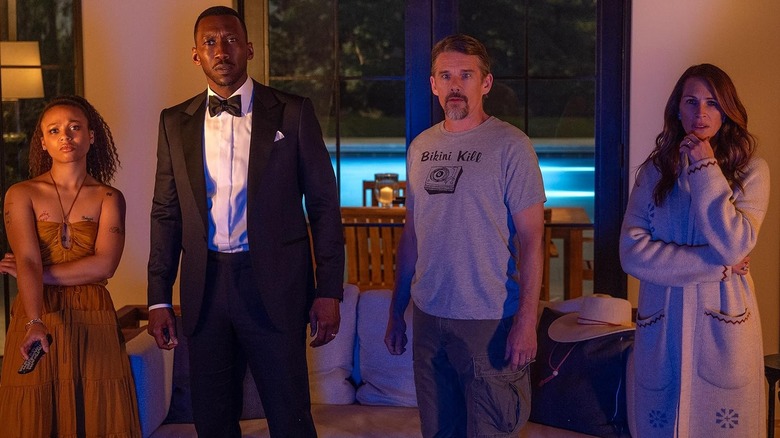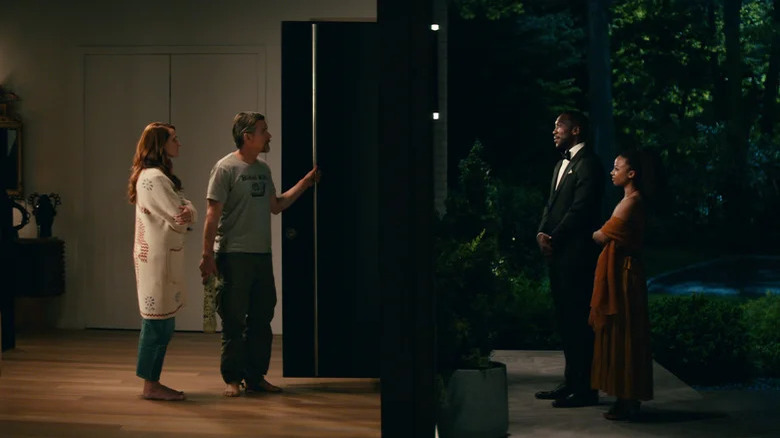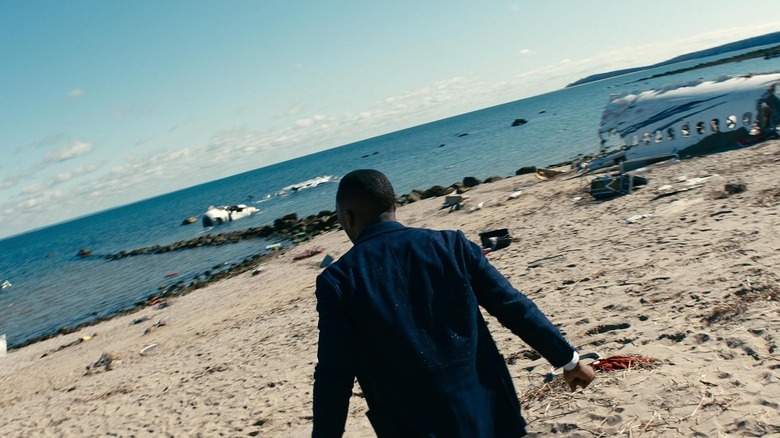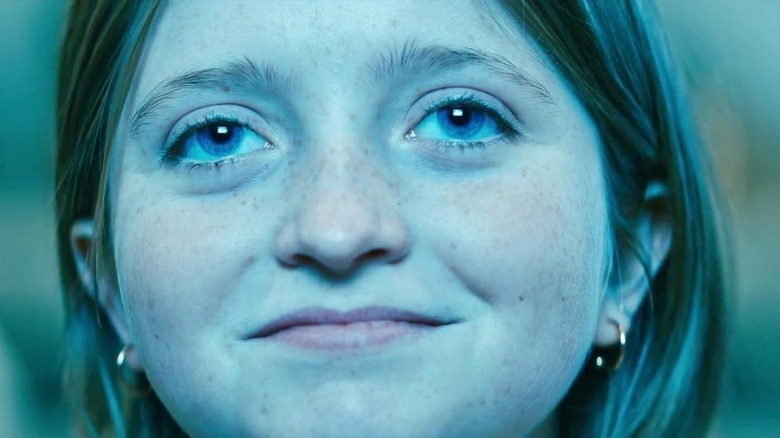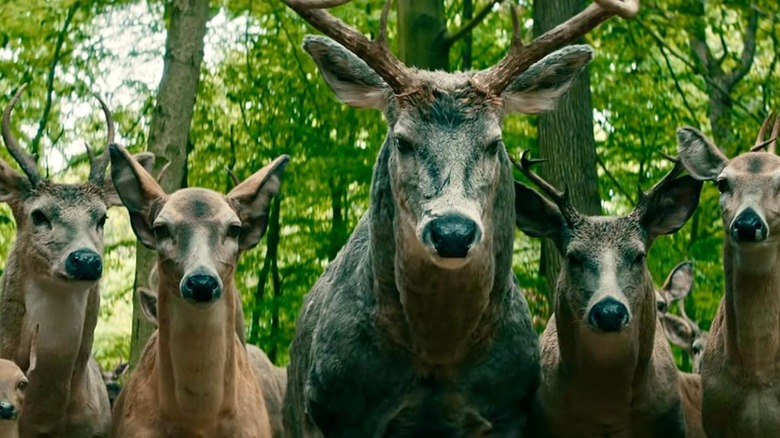Leave The World Behind Ending Explained: I'll Be There For You
It's hard to read the news these days without feeling a sense of existential dread flare up in your soul. Of course, we're nearly four decades removed now from Steve Martin picking up a newspaper and screaming in his classic '80s rom-com "Roxanne," so it's not as though fretting about the state of the world is a new sensation. Be that as it may, filmmakers have spent much of the 21st century postulating how human society might come toppling down. Perhaps global warming will do us in, like in "The Day After Tomorrow." Or maybe humanity's tampering with nature will produce a super-virus that plunges our global civilization into chaos, like in "Rise of the Planet of the Apes." That movie feels especially prescient in the wake of 2020.
In the Netflix-backed "Leave the World Behind," the apocalypse is triggered by a mysterious series of cyberattacks that seemingly culminates with the outbreak of full-blown civil war on U.S. soil (itself a concept that's quickly on its way to becoming a trend in speculative cinema). This tale of cyber paranoia sees writer/director Sam Esmail — adapting Rumaan Alam's 2020 novel of the same name — retreading old ground in the aftermath of his techno-thriller show "Mr. Robot," presenting the world as one where people have been rendered more isolated and vulnerable than ever by their nifty gizmos and gadgets. Which is not to suggest he's necessarily wrong, as anyone who works remotely can attest every time Slack goes down. *Shudders involuntarily.*
All the same, the film and especially its ending has rubbed some people the wrong way, be the reasons valid or just plain ridiculous. So, let's dive into its conclusion and what "Leave the World Behind" is even going for with its ambiguous final moments.
What you need to remember about the plot of Leave the World Behind
"Leave the World Behind" doesn't exactly try to endear us to its de facto lead, a well-to-do white woman named Amanda Sandford (Julia Roberts). "I f***ing hate people," Amanda declares in the movie's opening, having arranged for her and her family to leave New York City behind for a sporadic weekend getaway at a swanky estate in a Long Island town so small it's actually called a "hamlet." On the drive over, her husband Clay (Ethan Hawke) zones out listening to the radio. Meanwhile, Amanda chats with a peer on her Bluetooth, their son Archie (Charlie Evans) plays a violent video game on a handheld device, and their daughter Rose (Farrah Mackenzie) streams "Friends" on her iPad. This is all captured in what's shot and edited to look like a single take, to emphasize just how disconnected these four are from one another ... and just how much trouble they'll be in when their various electronics cease to function (as the scene foreshadows when Rose's stream glitches).
If it wasn't already crystal clear that Amanda is what you might call a "Karen," it becomes painfully obvious when she greets two strangers at their rental place later that night. The pair, a Black man named George Scott (Mahershala Ali) and his daughter Ruth (Myha'la), introduce themselves as the owners of the house, explaining that they sought shelter there over concerns of a sudden blackout in NYC. It quickly becomes apparent they're telling the truth — not that this prevents Amanda from subjecting them to a series of micro-aggressions and snide remarks, which George politely ignores (and his Gen Z daughter throws back in Amanda's face). Whether Amanda likes it or not, though, the two families are stuck under the same roof for the time being.
It's the end of the world as we know it ...
A lot of inexplicable stuff happens in "Leave the World Behind." An oil tanker crashes into a nearby beach. Later, when the Wi-Fi goes out and a national emergency alert hits the airwaves, Clay and George venture out to try and find more information, only to encounter crashing airplanes and drones drone-dropping leaflets with "Death to America" written in Arabic. Deer gather in huge numbers to stare ominously at any people they encounter. A flock of flamingos stops for a dip in the Scotts' pool. Esmail employs a whole bag of nifty tricks to further heighten the gnawing sense of tension as it grows throughout the film, many of which will be familiar to "Mr. Robot" enthusiasts and fans of paranoia cinema in general (off-kilter framing to make you emotionally uncomfortable, abrupt zooms for dramatic effect, swooping overhead shots that make it seem the world is literally flipping upside-down).
The confusion might just be the goal of whoever's behind all this (as George speculates). But "Leave the World Behind" itself isn't interested in what might cause the apocalypse; what it really wants is to explore how people respond when a disaster grows beyond anyone's control, even those responsible for it. Indeed, as the reality of what's happening sinks in, everyone gradually starts to let down their defenses: George bonds with Amanda before admitting that a powerful associate of his gave him a heads-up that something awful was about to go down; Clay and Ruth chillax and smoke a joint outside; Rose bemoans that she was only one episode away from finishing "Friends"; Archie, um, masturbates to photos he took of Ruth on his phone (without her permission). It's a simulacrum of how the general population reacts to bad news.
What happened at the end of Leave the World Behind?
When Archie's teeth begin falling out (either because of a nasty tick bite or possible radiation exposure), Clay and George seek out help from George's housing contractor Danny (Kevin Bacon), a survivalist. After some initial hostilities, they barter a deal for medication, with Danny mentioning that some local affluent types built a bunker in their home. Meanwhile, Amanda and Ruth go searching for a missing Rose, only to cross paths with countless deer — whom they scare away by yelling — before spotting what seems to be some kind of civil war breaking out in NYC on the horizon. As for Rose? She finds the empty doomsday bunker and discovers it's filled with just about everything you could want to survive for an indefinite period... including a DVD set of the last season of "Friends."
As the film closes with a close-up of Rose's blissful expression upon firing up the "Friends" finale (ignoring the cataclysmic warnings on a nearby set of computers), there's some room for interpretation. Is the film wagging its finger at Rose — and, by extension, us — for fixating on comfort viewing over taking action when the world is actively crumbling around her? If so, it's a rather harsh attitude to take towards a scared kid who just wants to know things are going to work out for her "friends" (who may be fictional characters, but they're real to her). Sure, that type of cynicism might be merited if Rose was a grown adult prioritizing their binge-watch over running back to bring everyone else to the bunker and then watching the "Friends" finale, but that's not the case.
Or perhaps the whole point is that this is what Rose needs right now (to "leave the world behind"), silly as it may seem from the outside looking in. Like so much of the film, the answer's not clear-cut.
What has Sam Esmail said about the ending?
With its emphasis on mood and characters talking in between the occasional thriller sequence, "Leave the World Behind" makes for a pretty unorthodox, "vibes"-heavy disaster movie. It's only natural, then, that it would prove a bit polarizing. The film deliberately avoids pat answers (or any kind of answers), preferring to instead examine the finer points of how people might reorganize and conduct themselves if they were stuck in the same place waiting out a much larger catastrophe (something we all got a taste of in 2020). Whether it does a good job of that, I shall leave it to you to decide.
While there are substantial differences between the film version of "Leave the World Behind" and its source material, they're both committed to avoiding any easy explanations for what's even going on in the story. Esmail anticipated the divisive reactions too, telling The Hollywood Reporter:
"We knew going into this that the ending was going to be polarizing, but we did not want to pull punches on it. I think in a traditional disaster film, a genre that I'm a huge fan of, so no knock on disaster films — I mean, 'Day After Tomorrow' is one of my favorite movies — but the expectation is at the end of these films, your cast of characters overcomes the disaster and the world reverts back to some sane semblance of normalcy. I knew that I wasn't going to do that."
"As a film lover, I'm excited when I leave a movie wanting to spend hours talking about it," he added, noting that his ultimate goal was to make a film that "provokes conversation" even at the risk of dividing the masses. Judging by the response from folks online (positive or not), he's certainly done just that.
"Leave The World Behind" is now streaming on Netflix.
